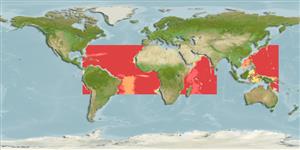>
Ophidiiformes (Cusk eels) >
Ophidiidae (Cusk-eels) > Neobythitinae
Etymology: Acanthonus: Greek, akantha = thorn + Greek, onos = hake.
More on author: Günther.
Environment: milieu / climate zone / depth range / distribution range
Écologie
marin bathypélagique; profondeur 1171 - 4415 m (Ref. 75877). Deep-water; 36°N - 23°S, 81°W - 154°E
In deep waters off tropical and subtropical areas of all oceans. Especially abundant in the tropical western Atlantic (Ref. 3686). Reported from Carlsberg Ridge (6°22'N 60°12'E) and New Guinea (Ref. 33390). Known from Gulf of Mexico, Caribbean Sea, southern India, Philippines, Gulf of Panama and tropical west Africa (Ref. 44076).
Taille / Poids / Âge
Maturity: Lm ? range ? - ? cm
Max length : 37.5 cm SL mâle / non sexé; (Ref. 34024)
Description synthétique
Clés d'identification | Morphologie | Morphométrie
Head large and body tapering. Snout with prominent, bifid spine. Opercular spine long and slender extending well beyond rear margin of head. Well developed spines at lower angle of preopercle. Eye small. Anterior gill arch with 16-22 developed rakers. Precaudal vertebrae 9-10.
Benthopelagic at bathyal and abyssal depths (Ref. 56809). Common species (Ref. 34024). Oviparous, with oval pelagic eggs floating in a gelatinous mass (Ref. 205). Noted as having the smallest relative brain size among teleosts, and remarkably large semicircular canals (Ref. 7463).
Life cycle and mating behavior
Maturité | Reproduction | Frai | Œufs | Fécondité | Larves
Nielsen, J.G., 1990. Ophidiidae. p. 564-573. In J.C. Quero, J.C. Hureau, C. Karrer, A. Post and L. Saldanha (eds.) Check-list of the fishes of the eastern tropical Atlantic (CLOFETA). JNICT, Lisbon; SEI, Paris; and UNESCO, Paris. Vol. 2. (Ref. 3686)
Statut dans la liste rouge de l'IUCN (Ref. 130435: Version 2024-1)
Menace pour l'homme
Harmless
Utilisations par l'homme
Pêcheries: sans intérêt
Outils
Articles particuliers
Télécharger en XML
Sources Internet
Estimates based on models
Preferred temperature (Ref.
123201): 1.8 - 4.1, mean 2.7 °C (based on 1440 cells).
Phylogenetic diversity index (Ref.
82804): PD
50 = 1.0000 [Uniqueness, from 0.5 = low to 2.0 = high].
Bayesian length-weight: a=0.00110 (0.00040 - 0.00297), b=3.08 (2.85 - 3.31), in cm total length, based on LWR estimates for this (Sub)family-body shape (Ref.
93245).
Niveau trophique (Ref.
69278): 3.6 ±0.6 se; based on size and trophs of closest relatives
Résilience (Ref.
120179): Milieu, temps minimum de doublement de population : 1,4 à 4,4 années (Preliminary K or Fecundity.).
Fishing Vulnerability (Ref.
59153): Moderate vulnerability (36 of 100).
